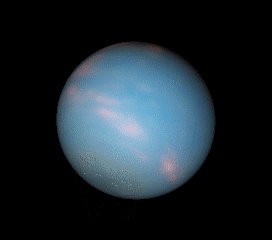Uranus: The Icy Giant at the Fringes of the Solar System

Uranus, the seventh planet from the Sun, is a distant and enigmatic member of our solar system. This icy giant, characterized by its unique rotation and pale blue-green hue, has long intrigued astronomers and planetary scientists. In this comprehensive exploration, we delve into the physical characteristics, unusual axial tilt, atmospheric composition, and the scientific mysteries surrounding Uranus.
Physical Characteristics:
Uranus, with a diameter of approximately 51,118 kilometers (31,518 miles), is the third-largest planet in our solar system. Unlike the gas giants Jupiter and Saturn, Uranus is classified as an ice giant due to its significant amounts of water, ammonia, and methane in its atmosphere and interior. The planet’s average density is lower than that of Jupiter and Saturn, indicating a larger proportion of icy and volatile materials.
Axial Tilt and Unusual Rotation:
One of Uranus’s most distinctive features is its extreme axial tilt. While most planets in the solar system exhibit a modest tilt, Uranus rotates almost perpendicular to its orbital plane, resulting in a staggering axial tilt of about 98 degrees. This unique orientation causes Uranus to essentially roll along its orbital path, leading to extreme seasonal variations.
Uranus experiences dramatic shifts in its seasons, with each pole alternately facing the Sun during its 84-year orbit. On Uranus, a day lasts just over 17 hours, and each pole experiences 42 years of sunlight followed by 42 years of darkness. This unusual axial tilt and rotation contribute to the complex dynamics of Uranus’s atmosphere.
Atmospheric Composition:
Uranus’s atmosphere is primarily composed of hydrogen, helium, and methane. The presence of methane in the upper atmosphere gives Uranus its distinct blue-green coloration, as methane molecules absorb red light and scatter blue light. The atmosphere also contains trace amounts of other hydrocarbons and compounds.
Uranus’s upper atmosphere experiences high-speed winds, with speeds reaching up to 900 kilometers per hour (560 miles per hour). The exact mechanisms driving these winds and the formation of atmospheric features are areas of ongoing scientific investigation.
Ring System:
Uranus possesses a system of 13 known rings, discovered during a stellar occultation in 1977 and later confirmed by the Voyager 2 spacecraft in 1986. The rings are dark and composed of small particles, likely a mixture of water ice, carbon, and silicate rock.
The rings of Uranus are named in order of their discovery, with the brightest and outermost ring called Epsilon. The rings exhibit a complex and dynamic nature, with features such as ringlets, arcs, and even a few shepherd moons contributing to their intricate structure.
Moons of Uranus:
Uranus has a system of 27 known moons, each with its own unique characteristics. The five largest moons—Miranda, Ariel, Umbriel, Titania, and Oberon—are collectively known as the major moons of Uranus. These moons vary in size, composition, and surface features.
Miranda, the smallest of the major moons, stands out for its unusual and varied terrain, including large fault scarps and cliffs. Ariel, with its relatively smooth surface, showcases signs of past geological activity, likely driven by internal processes. Umbriel, Titania, and Oberon exhibit diverse landscapes, with craters, canyons, and icy plains.
Miranda, in particular, presents a puzzle for scientists due to the stark differences in its terrain, suggesting a complex geological history that may involve processes such as tectonics and cryo-volcanism.
Magnetic Field and Spacecraft Exploration:
Uranus boasts a unique magnetic field that is tilted at a 60-degree angle to its rotation axis. This misalignment is believed to be a result of complex interactions within the planet’s interior. The magnetic field of Uranus is weaker than that of the gas giants Jupiter and Saturn but it still contributes to the dynamic interactions within its magnetosphere.
The Voyager 2 spacecraft provided the first and only close-up observations of Uranus during its flyby in 1986. The spacecraft revealed details about the planet’s atmosphere, ring system, and moons, significantly expanding our knowledge of this distant ice giant. Future exploration missions to Uranus are under consideration, aiming to unravel the remaining mysteries surrounding this intriguing planet.
Scientific Mysteries and Ongoing Research:
Despite the valuable insights gained from the Voyager 2 mission, many mysteries surrounding Uranus persist. The origin of its extreme axial tilt, the nature of its interior structure, and the driving forces behind its atmospheric dynamics are areas of ongoing research.
The complex and unique features observed on Uranus’s moons, especially Miranda, pose intriguing questions about the geological processes that shaped these icy worlds. Understanding the origin and evolution of Uranus and its moons contributes not only to our knowledge of the solar system’s history but also to the broader understanding of planetary systems in our galaxy.
Uranus is still one of the most interesting and strange planets in our solar system, with its icy composition, extreme axial tilt, and interesting system of moons. Scientific research, both in the past and the future, continues to shed light on how this faraway ice giant works and its complicated dynamics.
Uranus holds the promise of revealing more secrets about the early past and formation of our neighborhood in space as technology improves and our knowledge grows.



